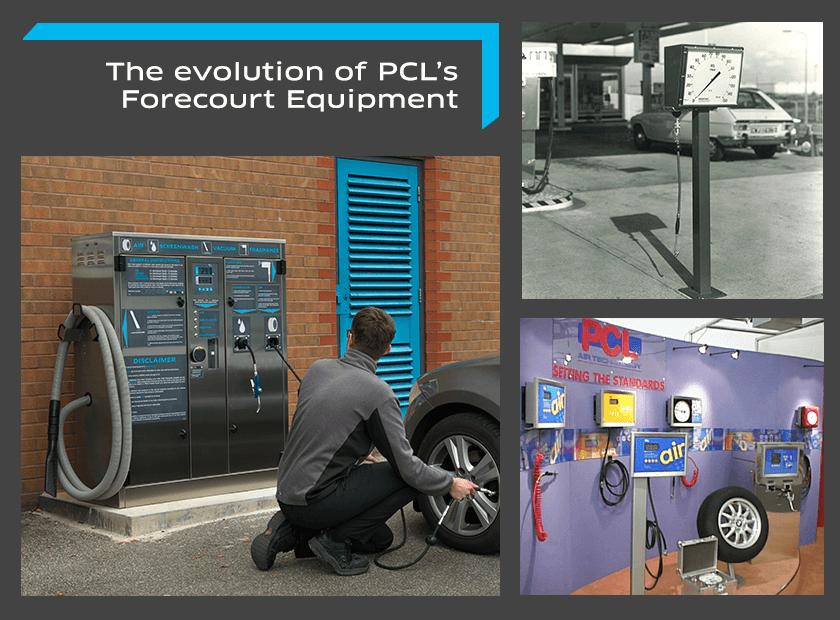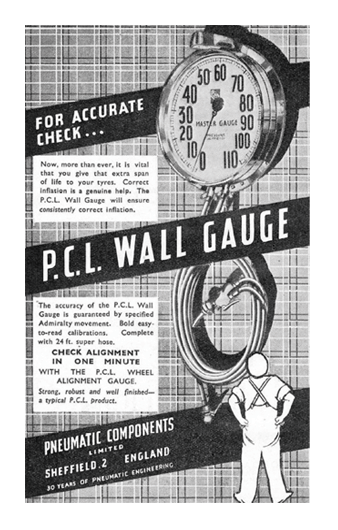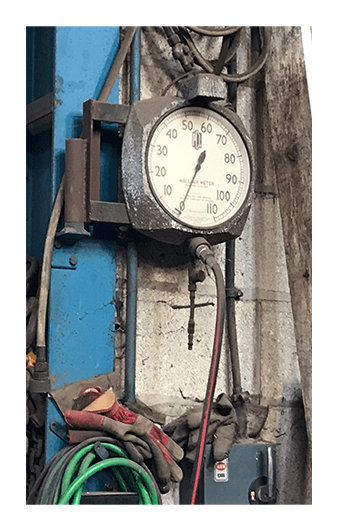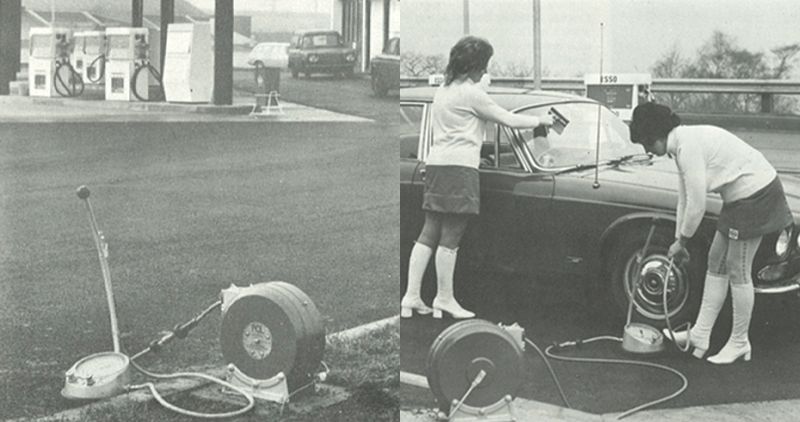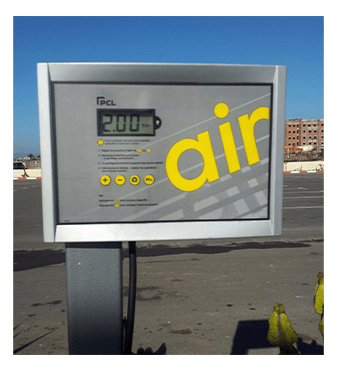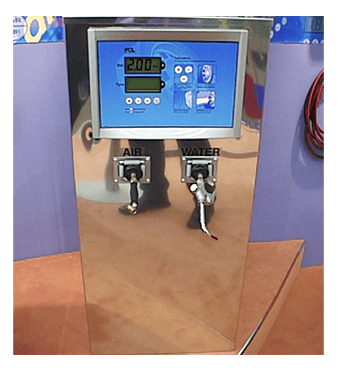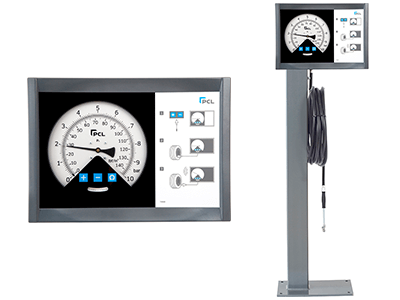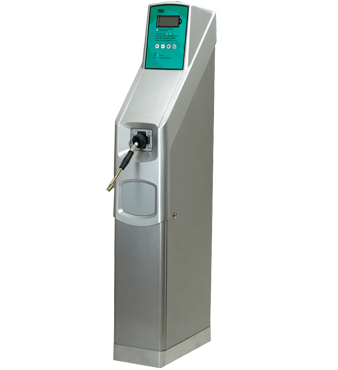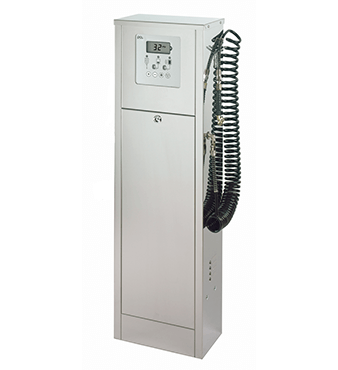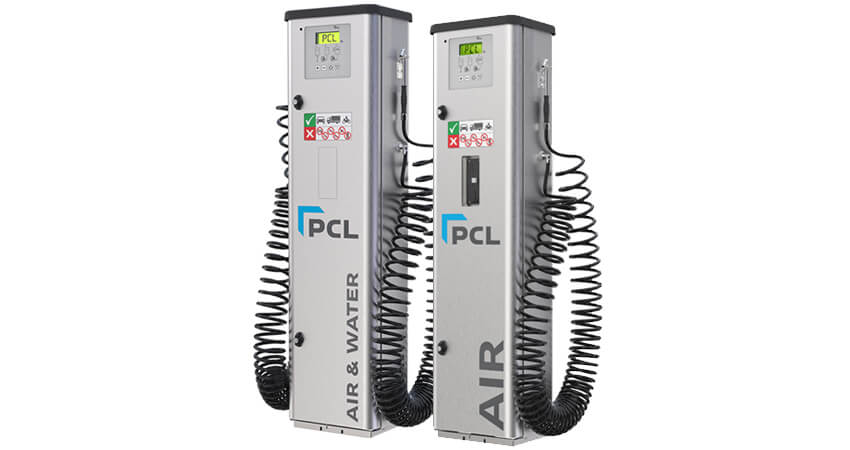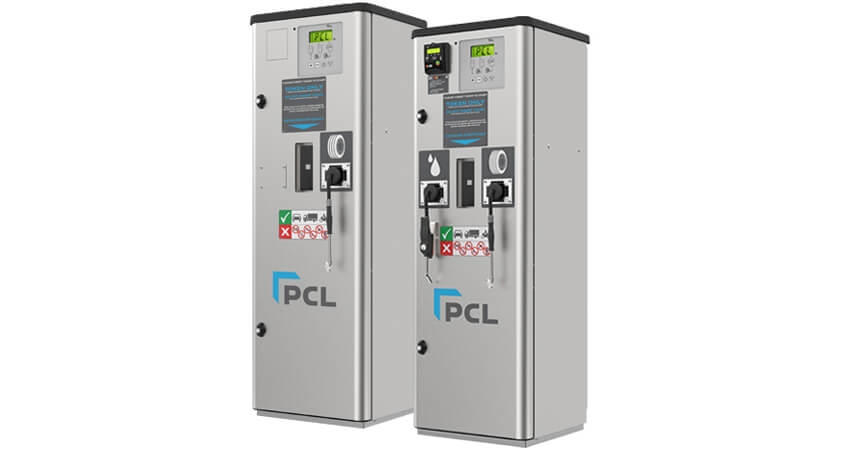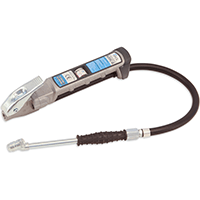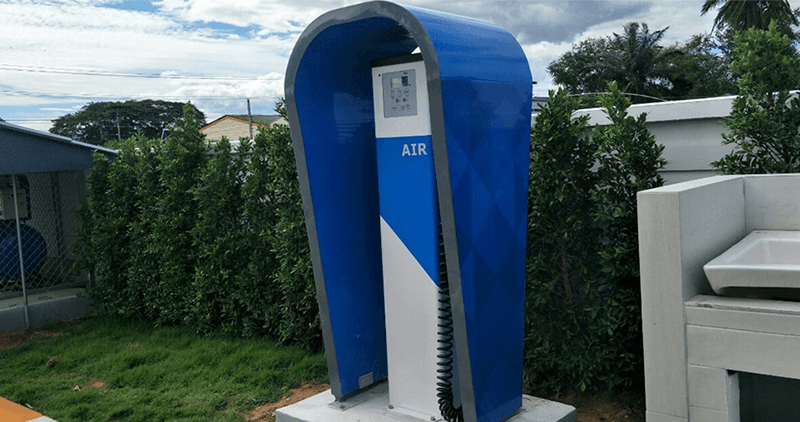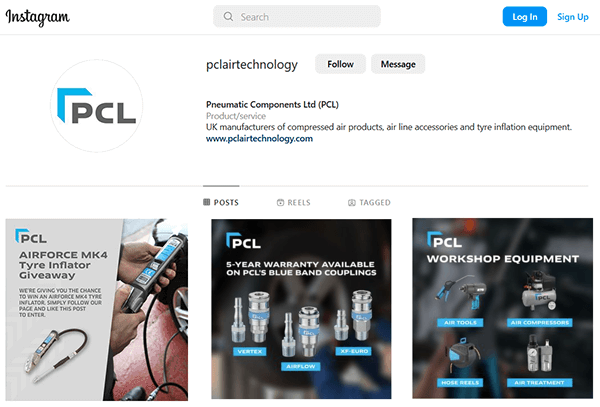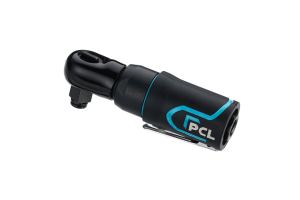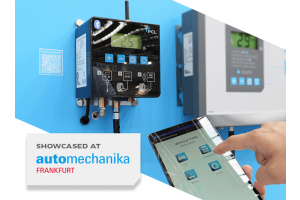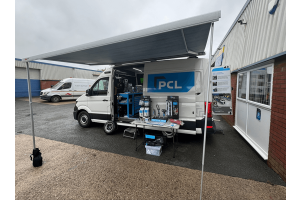The evolution of PCL's Forecourt Equipment
PCL has been designing and manufacturing equipment for use on Forecourts since the 1940s. Here’s a glimpse into the evolution of the range…
1940s
The journey begins with the Vertex air line gauge, better known as the MK2. Designed around the end of the Second World War in 1945, the MK2 was highly popular in garages and service stations for many years. PCL continued to develop Forecourt products for use with the MK2 gauge, such as the Air and Water post in the late 1940s. You can read more about the history of the MK2 and its evolution to the MK3 and MK4 here.
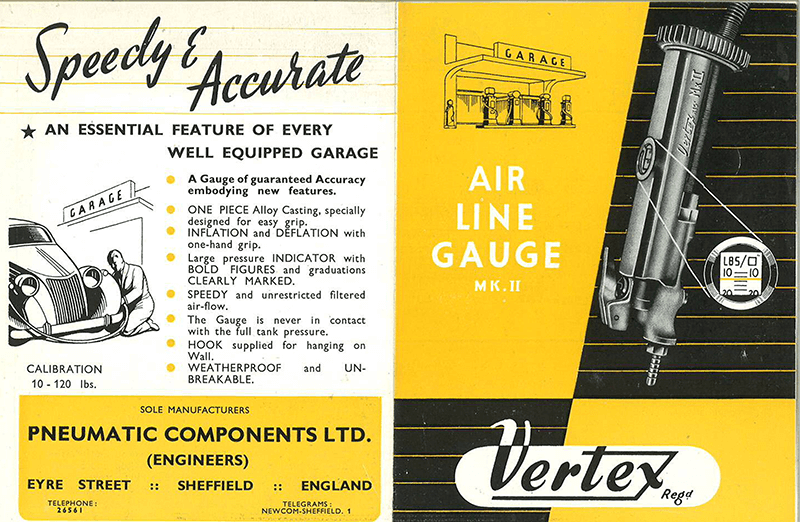
Promotional material for PCL's MK2 Vertex Air Line Gauge
By 1948, PCL had introduced the Wallair and Standard Air tower to the range, these products featured a remote-control type inflation and deflation, users could control the pressure by a single handed unit at the tyre end of the air line.
|
A promotional flyer for PCL's Wallair (1948) |
A 1950s Wallair in a garage still working today (2017) |
The range also included the PCL Junior model, featuring the same specification as the Wallair expect instead of a 10 inch dial, it featured a 7 inch dial.
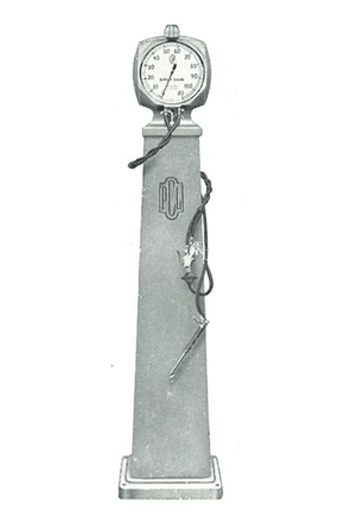 PCL Standard Air Tower from the 1956 Catalogue |
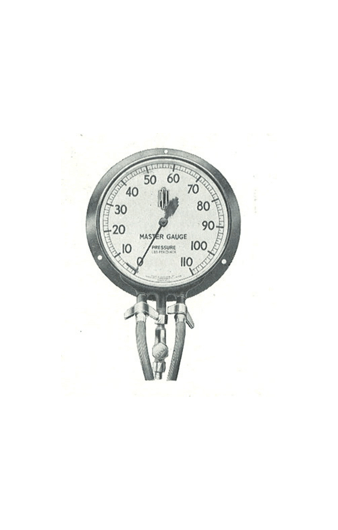 PCL Junior Model Wall Gauge from the 1956 Catalogue |
1950s
In 1950, PCL filed a patent for the new Comparator Dial, which was a hand control featuring a dial, this enabled the operator to inflate and deflate a tyre without the need to refer to the master gauge dial to check the pressure and meant the actual pressure in the tyre was always visible to the driver.
The new comparator dial was incorporated on new products in the range, including the MARK III and MARK IV Air Meters.
The main different between these two models, is that the MARK III hose could be easily detached from the pedestal, while the MARK IV featured integrated retractable hose.
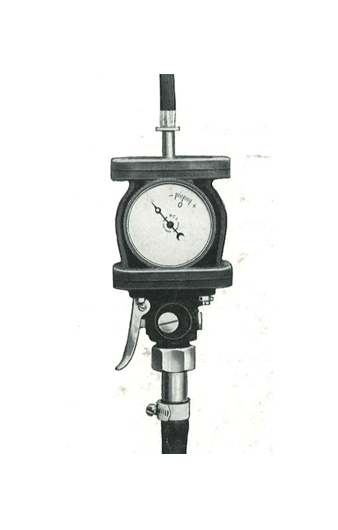 Comparator Dial |
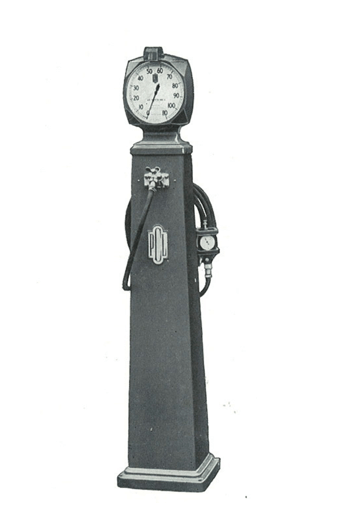 MARK III Air Meter |
In 1952, PCL filed a patent for the first mechanical pre-set meter, a prototype of the Presetair was then displayed on PCL’s stand at the 1954 Motor Show in London.
This product allowed vehicles tyres to be automatically inflated to a target value set on a display. You can read more about the history of the Presetair here.
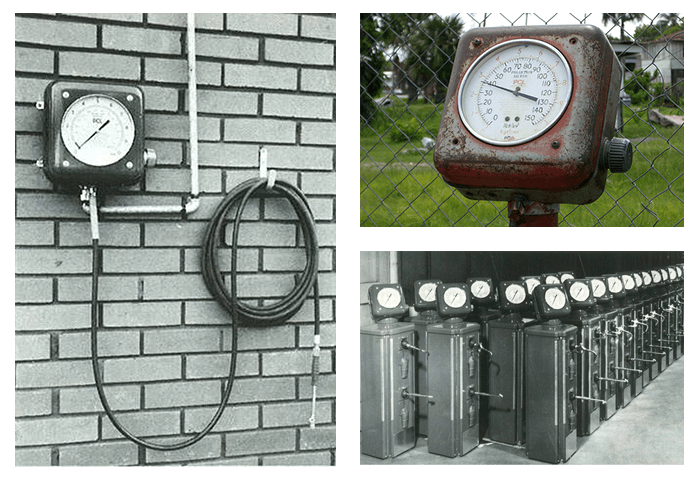
PCL’s Presetair meters [Left: Wall mounted at Shell UK, Top right: Still in use on a Forecourt today, Bottom right: Lined up in our Eyre Street factory ready for despatch to a major middle east oil company in 1982]
The 1956 catalogue announced a range of new products including the MARK V which featured a rotating head, and the REELAIR Air and Water Tower with retractable hoses featuring the MK2 for accurate inflation, the Air and Water Post and a newly designed radiator filler.

Extract from PCL's 1956 Catalogue
1960s
In the early 60s, PCL introduced an upgrade of the MARK V. The MARK Va now featured a speed-controlled mechanism which maintained the rate of the hose retraction to a constant and safe speed so there was no whipping of hose. The range also now offered more product options to suit customers’ preferences such as comparative dial option, as well as air only or air and water versions of the tower.
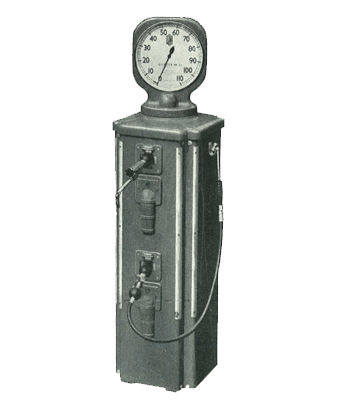 MARK Va in PCL's 1960 Catalogue |
![Before [Top] and after [Botton] images of the MARK Va on the Find it, fix it, flog it TV show](https://euro.pclairtechnology.com/media/wysiwyg/MARK_Va.png) Before [Top] and after [Botton] images of the MARK Va on the 'Find it, fix it, flog it' TV show |
PCL also extended the product options for the Presetair and Wall Gauges, these versions were available with the companion hose reel as optional.
The 1963 catalogue introduced the Rotair and Pavement Gauges to the forecourt range.

New products in PCL's 1963 catalogue
PCL’s Rotair featured the same specification as the Wallair, however was installed on a pedestal with a 270o swivel head.
PCL’s Pavement gauges, which are still manufactured in Sheffield today, feature a convenient carrying handle for easy transport, large foot-operated push-button controls that are clearly identified and angled near to floor level for easy operation and minimum effort.
The 1963 catalogue also introduced more compact and cost-effective options of the Rotair, Wallair and Standard meters. These were referred to as the ‘60’ models, and featured slightly smaller dials at 9 inches, and could be easily distinguished by the rounded head.
|
Esso chooses PCL |
|
|
|
Pictured here are two PCL Pavement Gauges with Companion Hose Reels - chosen for their ruggedness and ease of operation - at Essos M1 Service Area at Woolley Edge near Wakefield. |
Extract from PCL's 1970 Internal Newsletter
1970s
With ambition to heighten our reputation as leading manufacturer for quality and performance, the Tyrair was launched in 1970 after substantial development cycle lasting 3 years.
Featuring an internal hose reel, it had a modern head design with a larger, illuminated dial face. With this product range, users inflated the tyre by hand, reading the pressure on the remote display.
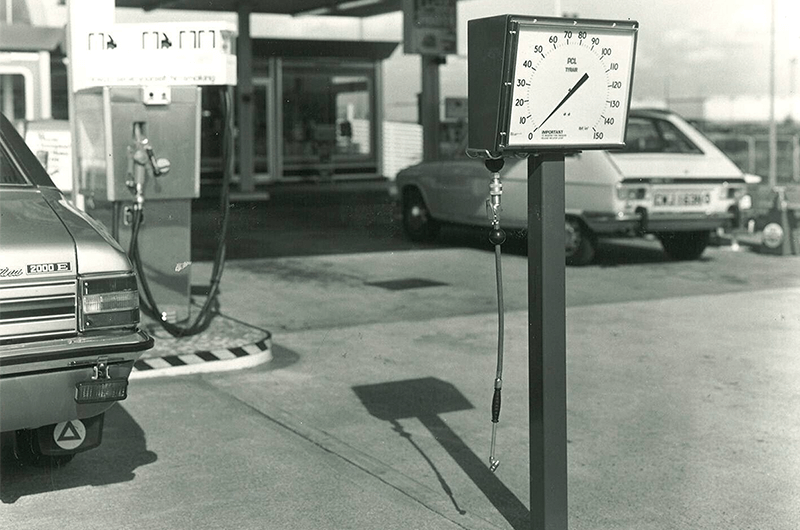
PCL's Tyrair, 1970
In 1975, the Presetair De-Luxe joined the range. The De-luxe addition incorporated the same reliable and well-tried mechanism as the standard Prestair, but was now available in a new style of cabinet and built-in hose reels, similar to the Tyrair Meter following its success.
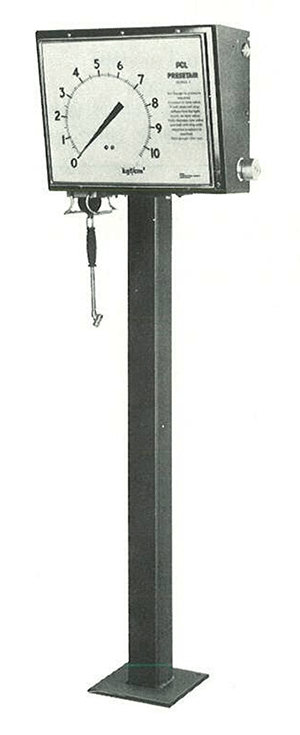
Presetair Deluxe. Read more about the history of the Presetair here.
With the introduction of the AIR620 in 1975, there was no reason for forecourts to have air line gauges or hoses lying on the ground. It provided a quick and easy way to hang up both MK2 gauge and hose.
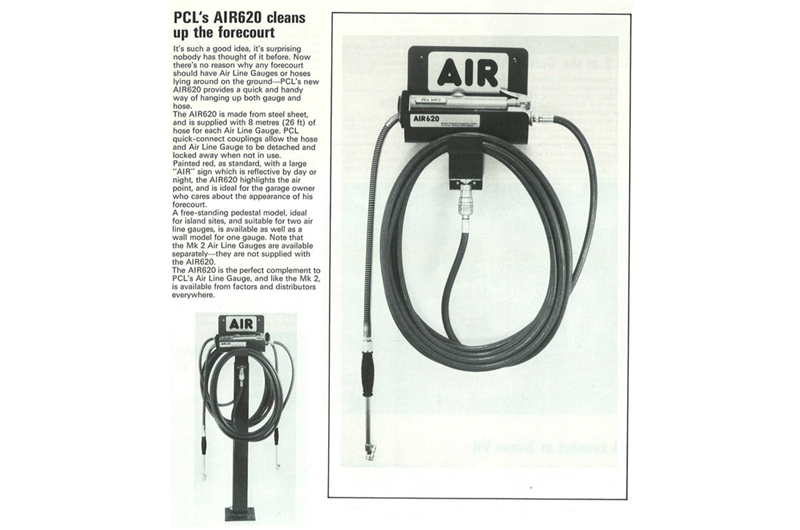
"PCL's AIR620 cleans up the forecourt" article from PCL's Spring 1975 Internal Newsletter
1980s
Creating products unlike any other in their market has always been part of the PCL identity. In a world first, a model of the new electronic pre-set was made available at the prestigious Automechanika show in Frankfurt, Germany.
For the first time, it was now possible to automatically inflate and deflate vehicle tyres electronically.
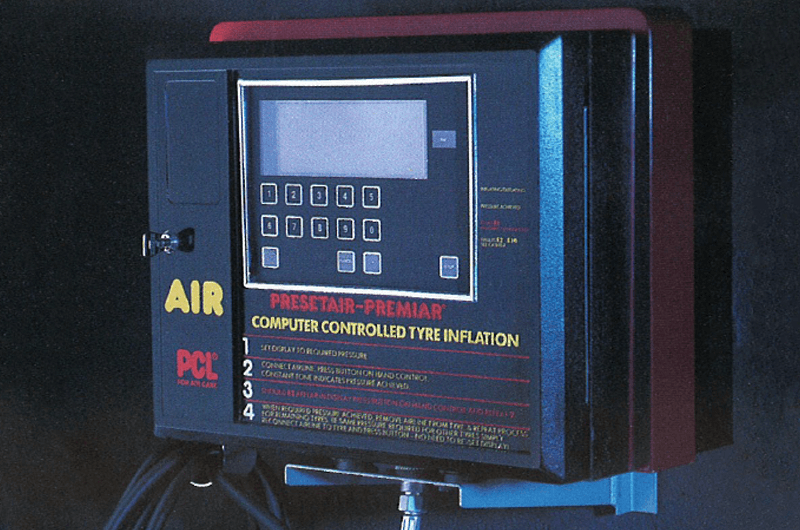
PCL's first eletronic preset intflator, Presetair-Premiar, 1987
The Premiar mechanical range was also showcased at Automechanika. These models featured a coin, token or free air vend options.
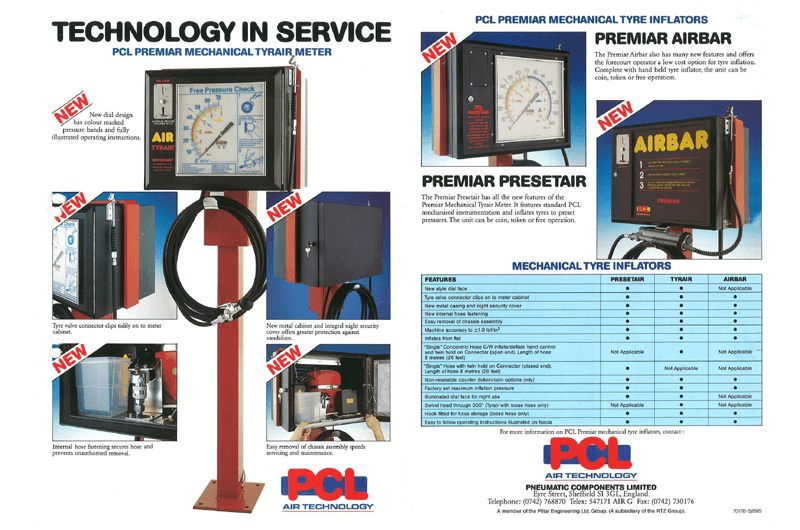
Flyer for the Premiar mechanical range
In 1988, PCL acquired the UK arm of Italian vehicle washer manufacturer Autoequip Lavaggi for 24.5 million. A new company, PCL Cygnus, began to manufacture and market the equipment in our Sheffield Factory.
1990s
In the 1990s, PCL Cygnus grew, not just locally as shown in the photo below but globally by establishing distributors in Portugal, Holland, Korea, Eire and Australia. By the mid 90s, PCL and PCL Cygnus became one company.
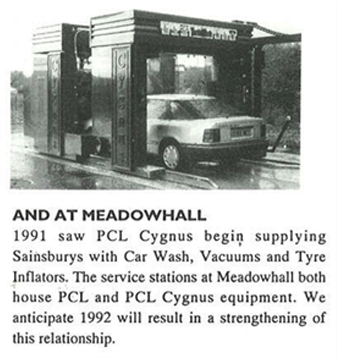
Snippet for PCL’s Internal Newsletter, 1992
As the MK2 was a popular on forecourts around the world, to meet the new harmonised European standards, in 1992 PCL introduced the MK3 Inflator with approval 86/217/EEC.
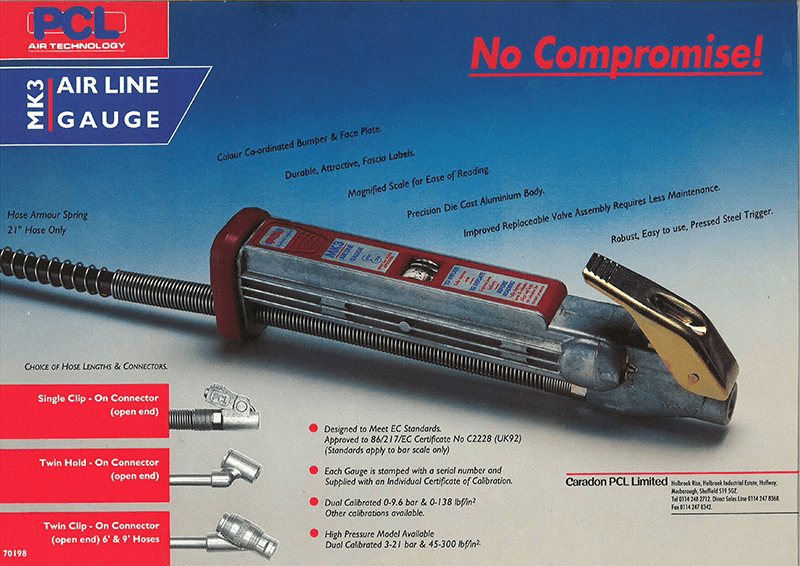
MK3 (ALG3) Tyre Inflator from PCL's 1990s Tyre Inflation Brochure
The MK2 was not the only product to receive a face lift, in 1997 the Presetair was modified with an adjustable timer and a louder ring, and the Portair was re-designed to include an aluminium tank which was 2 kg lighter making the unit easier to use.
2000s
PCL launched a new range of automatic digital tyre inflators including the ACCURA D10 Wall or Pedestal mounted and D30 Tower for forecourts, garages and workshops at Automechanika Frankfurt 2002.
The ACCURA D10 is still manufactured by PCL today, and can be spotted on many forecourts around the world as pictured below. This is a popular choice for forecourts that require a free vend air only or air and water wall mounted or pedestal unit.
|
D30 Tower at Automechanika Frankfurt 2002 |
The following year, PCL introduced the A10, an electronic analogue automatic tyre Inflator. This product has a pre-settable pointer that works well in markets that do not prefer numeric LCD screens.
In the same year, PCL launched the D60 OEM Kit, which is ideal for customers who have their own cabinets/housings but want a reliable and highly accurate software system.
PCL continued to innovate, building on the firm foundations of its successful D50 Free-Standing Digital Tyre Inflation tower that was launched four years earlier, and in 2009 PCL launched the new, improved D80 range.
The D80 retained all the features of the D50 but in an even more cost-effective package, offering further options and a higher specification.
Offering lower cost, slimline tower with air and water options, through to the self-contained built-in retractor range. Both can house standalone compressors making any model of D80 the ultimate in flexibility due to its ability to cope whether mains air is available or not.
|
D50 Air Tower launched in 2005 |
D80 Air Tower launched in 2009 |
2010s
In 2014, the D80 was updated to the sleeker D90/D95. These Premium Tower units are available with hose reels or coiled hoses to suit market preference, and are available with built-in compressors and range of payment options - free vend, coin/token and cashless - suitable for use on modern forecourts around the world.
|
D90 - D93 Air Towers |
D95 - D98 Air Towers |
The upgrade from the popular linear-style MK3 hand-held inflator to the AIRFORCE MK4 in 2016, provided forecourts that required a cost-effective handheld inflator with a more durable, accurate option.
In 2017, to extend its forecourt equipment offering, in a similar style to PCL’s D95 range, PCL launched the Vacuum and Fragrance units.
Utilising a robust stainless steel cabinet as standard that can be bolted to the ground, however the units include a powerful vacuum for trouble-free use and fast cleaning and with its bagless technology is simple to install, use and maintain. The Fragrance module comes with a fragrance gun with 3m armoured hose. The unit offers proportional price control between vacuum and fragrance allowing customers to swap during the vend.
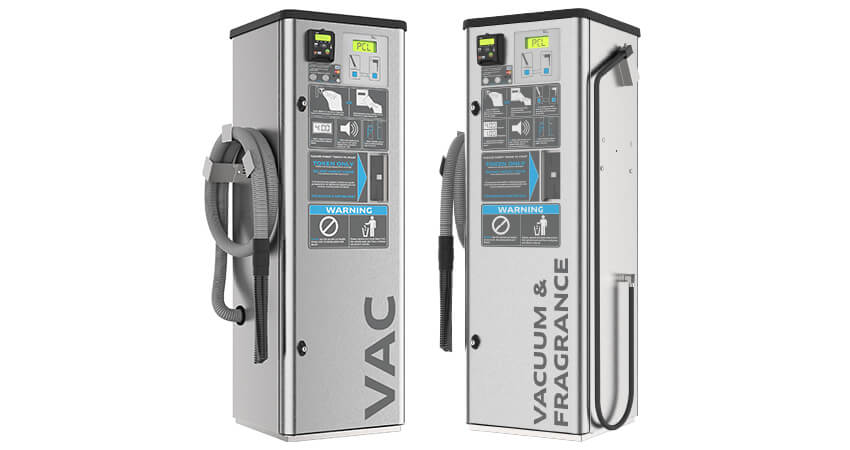
V950 and V960 Vacuum and Fragrance Towers
PCL exhibited at UNITI Expo 2018 where the D90 range was showcased along with the new forecourt inflation range including the N90/N91 Nitrogen Tower, D30/D31 Air Podium, N30/N31 Nitrogen Podium, and Retail Diesel Emission Fluid Dispenser.
The increasing use of nitrogen in tyres led PCL to develop its Nitrogen range with the premium N90 / N91 freestanding nitrogen generation tower, these units provide the opportunity for car users to fill / top up their tyres on the forecourt while making an additional revenue opportunity for the forecourt.
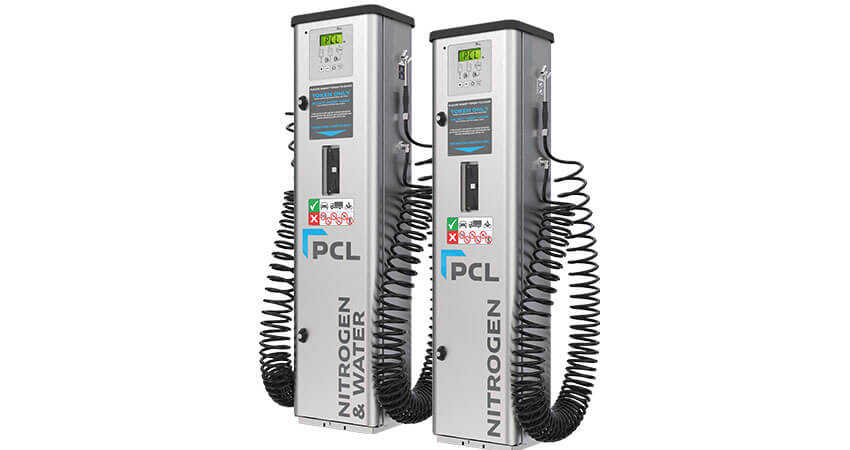
N90/N91 Nitrogen Tower
The Podium-Style D30 / N30 Units are the slimline version of the D90 and N90 Towers and come with a basic range of options, presenting a value alternative for forecourt operators looking for a housed air or nitrogen product.
Featuring the same inflation technology as the D90 range, but in a more compact design and style of unit, they are PCL’s most cost-effective freestanding unit to date. The space saving design make them ideal for congested locations.
PCL Partnered with Prime Parizon to supply Air Towers to oil & gas gaint PTT with D30 Towers
The Retail Diesel Emission Fluid Dispenser for AdBlue® combines PCL’s tyre inflation and forecourt knowledge with sister company TECALEMIT’s fluid expertise to provide a new concept in AdBlue® forecourt dispensing and tyre inflation provision. The use of the proprietary software “BlueTime” allows customers to conveniently purchase a fast and timed AdBlue® dispense and/or tyre inflation cycle using a cashless payment module.
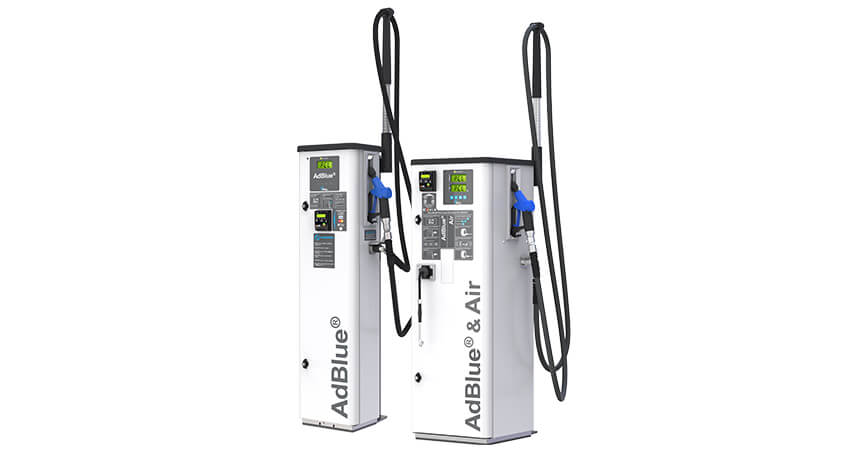
Retail Diesel Emission Fluid Dispenser for AdBlue
2020s
In 2021, PCL launched the versatile “Multi” unit which provides tyre inflation, water/screen wash, vacuum and fragrance all in one space-saving cabinet, enabling forecourt owners to provide a wide range of revenue-generating services in a smaller footprint.
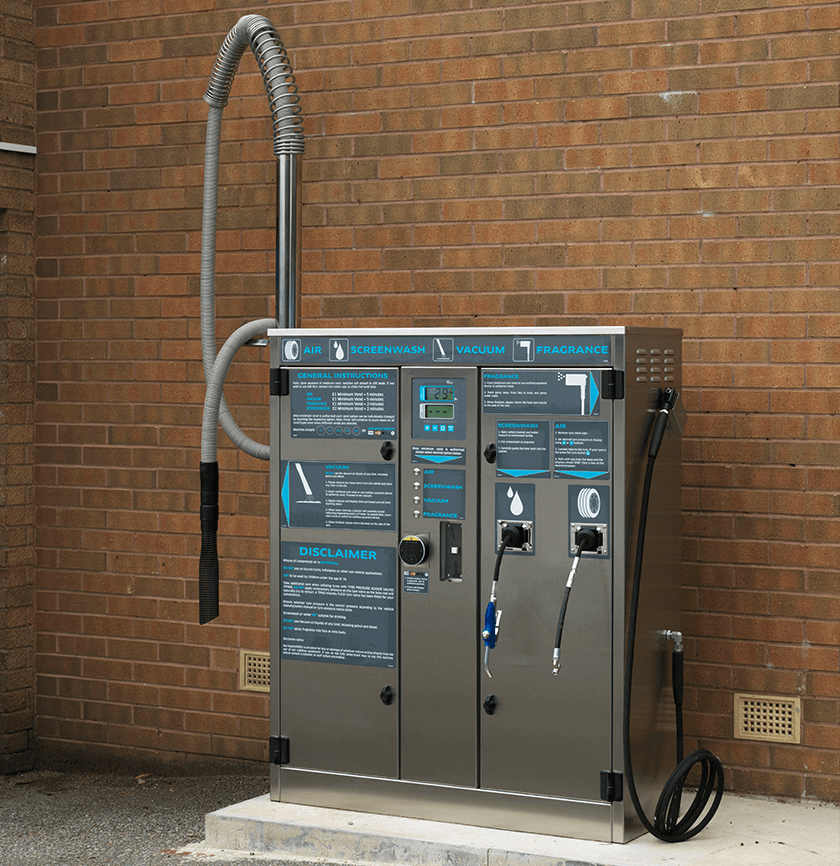
PCL's 4-in-1 Multi-function Digital Tower
Following the EU’s decision to rule against a unified directive for tyre inflation, from 2020, manufacturers have to apply for national standards within the EU. In 2022, PCL became the first and only manufacturer of tyre inflation equipment to obtain Spanish CEM (Centro Español de Metrologia) approvals for its factory and full portfolio including its mechanical and digital inflation range meaning our customers in Spain can feel assured they are buying the best brand for tyre inflation available.
2023 and onwards...
PCL continues to develop new and existing products to meet the exacting and testing demands of the forecourt. Watch this space as PCL are currently developing some exciting new additions to the range.
Have you spotted any PCL Forecourt Equipment on your travels? Or do you have own a PCL product? Old or new we’d love to see it! Tag us on Instagram @pclairtechnology.



